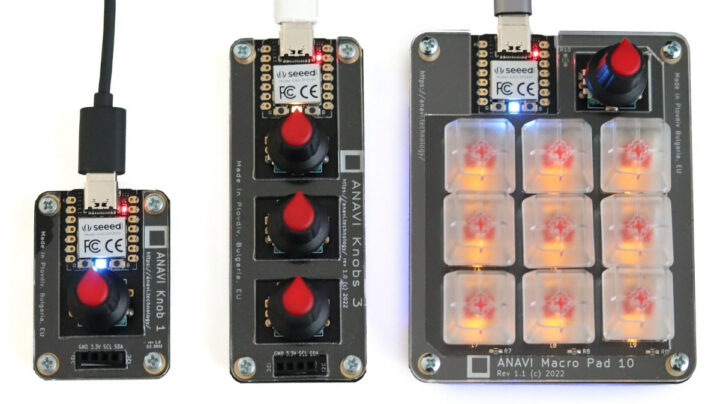ANAVI Macro Pad 10, Knobs 3, and Knob 1 are open-source hardware input devices based on the Raspberry Pi RP2040-powered Xiao RP2040 mini module, and equipped with mechanical keys and/or rotary encoders
Leon Anavi has some experience under his belt with the earlier Macro Pad 2 and Macro Pad 8 open-source keypads with mechanical keys running QMK open-source firmware on a Microchip 8-bit microcontroller. The new models switch the MCU to the Raspberry Pi RP2040 and to KMK open-source firmware written in CircuitPython.
ANAVI Macro Pad 10 specifications:
- MCU module – Seeed Studio XIAO RP2040 with Raspberry Pi RP2040 dual-core Cortex-M0+ microcontroller @ up to 133 Mhz with 264KB SRAM, 2MB SPI flash, USB Type-C port
- Inputs – Rotary encoder with clickable switch and nine hot-swappable Cherry MX-style switches
- Keys – 9x Gateron red, linear, non-clicky mechanical switches and transparent keycaps with yellow LED backlighting
- Host interface – USB Type-C port from XIAO RP2040 module
- Misc – RGB LED for each key on top, 4x WS2812B addressable LEDs for bottom-lighting
- Dimensions – 91 x 73.0 mm
The Knobs 3 and Knob 1 also rely on the Xiao RP2040 module, but do not include keys at all, instead featuring three and one clickable rotary encoders respectively, as well as an I2C header to add an optional OLED display or other I2C peripherals. All three input devices run the KMK firmware compatible with Windows, macOS, and Linux operating systems.
The solutions are open-source hardware, and besides the open-source KMK firmware, KiCad hardware design files are also provided on GitHub.
All three input devices are available on Crowd Supply crowdfunding platform with the ANAVI Marco Pad 10 going for $45, the Knobs 3 for $32, and the Knob 1 for $29. Shipping is free to the US and adds $12 to the rest of the world. Backers should expect their rewards to ship around mid-January 2023.

Jean-Luc started CNX Software in 2010 as a part-time endeavor, before quitting his job as a software engineering manager, and starting to write daily news, and reviews full time later in 2011.
Support CNX Software! Donate via cryptocurrencies, become a Patron on Patreon, or purchase goods on Amazon or Aliexpress






